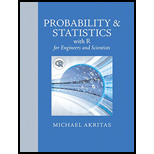
(a)
Find the probability that the sample contains no defective fuses.
(a)
Answer to Problem 10E
The probability that the sample contains no defective fuses is 0.467.
Explanation of Solution
Calculation:
The conditional probability for any two events A, B with
Let
A batch of 10 fuses contains three defective ones.
The probability that the first one is defective is,
The probability that the first one is not defective is,
The probability that the second is defective given that first is defective is,
The probability that the second is not defective given that first is not defective is,
The probability that the second is not defective given that first is defective is,
The probability that the sample contains no defective fuses is,
Hence, the probability that the sample contains no defective fuses is 0.467.
(b)
Find the probability mass
(b)
Answer to Problem 10E
The probability mass function of X is,
| X | 0 | 1 | 2 |
| Probability | 0.467 | 0.466 | 0.067 |
Explanation of Solution
Calculation:
The formula for complement of
Let X denotes the random variable denoting the number of defective fuses in the sample.
The probability that the sample contains no defective fuses is,
The probability that the sample contains defective fuses is,
The probability that the sample contains one defective fuse is,
Hence, the probability mass function of X is,
| X | 0 | 1 | 2 |
| Probability | 0.467 | 0.466 | 0.067 |
(c)
Find the probability that the defective fuse was the first one selected given that
(c)
Answer to Problem 10E
The probability that the defective fuse was the first one selected given that
Explanation of Solution
Calculation:
Bayes’ theorem:
The Bayes’ formula is,
The probability that the defective fuse was the first one selected given that
Hence, the probability that the defective fuse was the first one selected given that
Want to see more full solutions like this?
Chapter 2 Solutions
Probability & Statistics with R for Engineers and Scientists
 A First Course in Probability (10th Edition)ProbabilityISBN:9780134753119Author:Sheldon RossPublisher:PEARSON
A First Course in Probability (10th Edition)ProbabilityISBN:9780134753119Author:Sheldon RossPublisher:PEARSON

